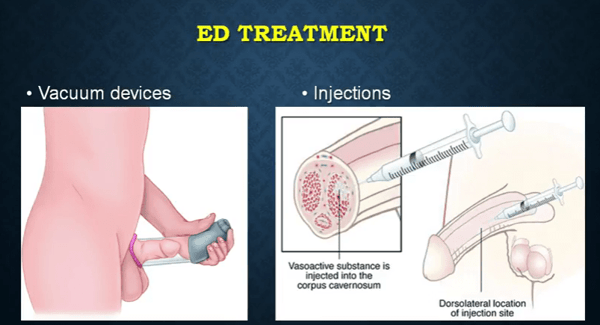Prostate cancer treatment side effects understandably cause much concern in patients and their loved ones. Recently, we discussed urinary incontinence. Today, we're discussing another side effect: erectile dysfunction.
We're pulling the following information from a presentation that Dr. Natalya Lopushnyan, one of our fabulous physicians, gave at the Prostate Cancer Symposium this past May. (Click here to watch the complete presentation.)
As with all content on Greater Boston Urology's blog, the following information is educational in nature, not medical advice. Always talk to your physician about your specific health care questions and conditions.
[Editor's note: This article was reviewed and updated on 4/17/21 with additional links and media.]
Understanding Erections
A pair of sponge-like regions of erectile tissue (corpus cavernosa) is located inside the penis. When a male is aroused, blood rushes into the penis and fills up the spongy tissue, resulting in an erection.
Healthy blood vessels (which deliver the blood) and healthy nerves (which essentially tell the blood vessels what to do) are a critical part of this process. If the blood vessels and nerves are damaged or missing, this will inhibit the flow of blood to the penis, resulting in poor erections or no erections.
Got Erectile Dysfunction? You're Not Alone video
Prostate Cancer Treatments That Can Affect Erections
Both blood vessels and nerves can be affected by certain prostate cancer treatments, specifically radiation and prostatectomy.
What happens during radiation?
During radiation, the cells of the prostate are killed with radiation. Nerves are located very closely to the prostate, so they can be affected as well. It's important to note that erectile dysfunction doesn't typically happen right away; it develops gradually.
The patient will probably notice that his erections get worse and worse over time. This happens because radiation kills cells and leads to "fibrosis" or death of nerves and blood vessels around the prostate. It may take several years to develop. Three to five years after radiation, men who had radiation versus men who had surgery will have the same erectile issues, on average.
The better your erectile function is before radiation, the better it likely will be after radiation, because the healthier you are before, the healthier you'll be after.
[Editor's note: Learn about SpaceOAR Hydrogel for men undergoing radiation treatment for prostate cancer and how SpaceOAR can reduce the risk of side effects, like ED.]
What happens during prostatectomy?
When we remove the prostate, we try to "peel" off the nerves in order to leave them inside the body since they are an essential component to producing erections. Sometimes, however, the prostate cancer has gone outside of the prostate and we will have to take both nerves.
After a prostatectomy, ejaculation is usually lost. That's because the ejaculate comes in right where the prostate is and then it comes out of your penis. If you remove the prostate, there will be no ejaculation.
However—and this is an important note—the orgasm sensation usually stays. Many people associate orgasm with ejaculation, but those are two completely separate sets of nerves and processes that bring those two things together.
After a prostatectomy, most men will be able to have orgasms, they will have sensation in their penis, but they will not be able to ejaculate.
So what happens if you do experience erectile dysfunction after prostate cancer treatment? What are your options?
Penile Rehabilitation
Penile rehabilitation involves actions that you can take, under the guidance of your urologist. In order to preserve penis health, it's important for patients to achieve erections after treatment (as soon as it's safe to do so) and to keep getting erections (even if they're artificial). Don't try any of the following unless you've discussed the option with your doctor and you're healthy enough to have sexual intercourse.
1. Medications. The first line of treatment typically involves medications that most readers are probably familiar with, such as Viagra, Levitra, Cialis, etc. These medications can be very effective, especially for younger, healthier patients who have nerves that are preserved.
2. Vacuum devices. This involves a small tube fitted onto the penis. Some are manual; some are electronic. Essentially, the tube sucks the blood into the penis, filling the spongy tissues. The patient then puts a penis ring at the base of the penis, which helps contain the blood. Some men like this device; others find it cumbersome. It's a personal decision.
3. Injections. If the patient hasn't had luck with medications or the vacuum devices, injections are another option. A small needle delivers active medication directly to the penis. Again, this is a personal decision.

4. Penile prosthesis. The prosthesis replaces the spongy erectile tissues with two cylinders that a surgeon implants into the penis. A little pump is placed inside the scrotum (not the testicle, but the scrotum) and a little reservoir that goes at the bottom of the patient's belly houses fluid that's used to inflate the cylinders. The patient will use the pump to get an erection. There is a little button that that the patient pushes to make the penis flaccid or soft again.
The surgical procedure takes about an hour to an hour and half to do in the operating room. There are certain risks, as with any surgical procedures. It takes about four to six weeks to heal.
A penile prosthesis offers good longevity, and it's a reliable option because the patient achieves an "on-demand" erection every single time. Surprisingly, even though it's a surgical procedure, it has great satisfaction rates, not just for patients but also for their partners.
At Greater Boston Urology, we understand how important sexual function is not only from a physical standpoint, but also from an emotional one for a patient and his partner. We can help. If you are interested in setting up a consultation with one of our urologists, please schedule an appointment.
